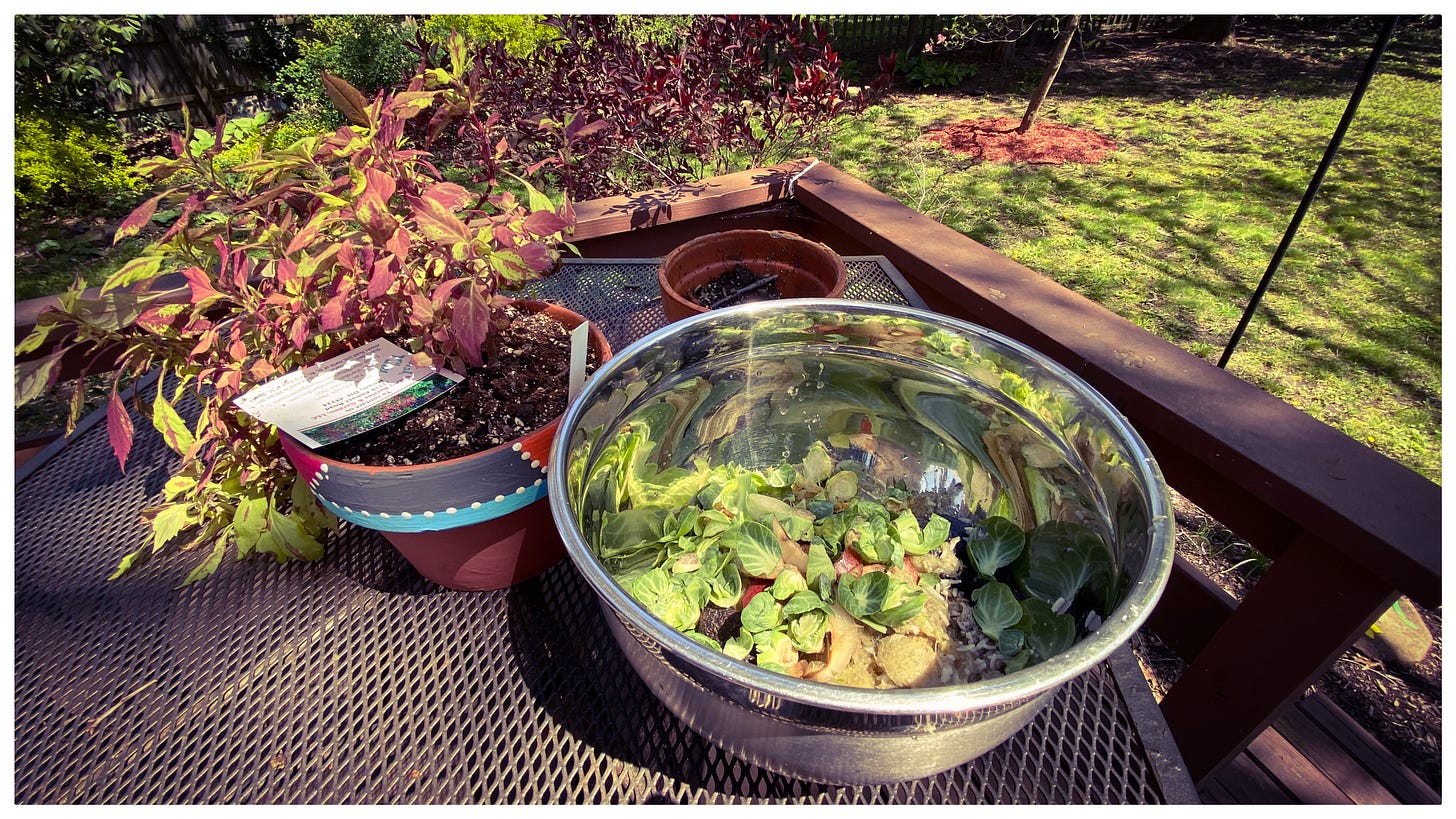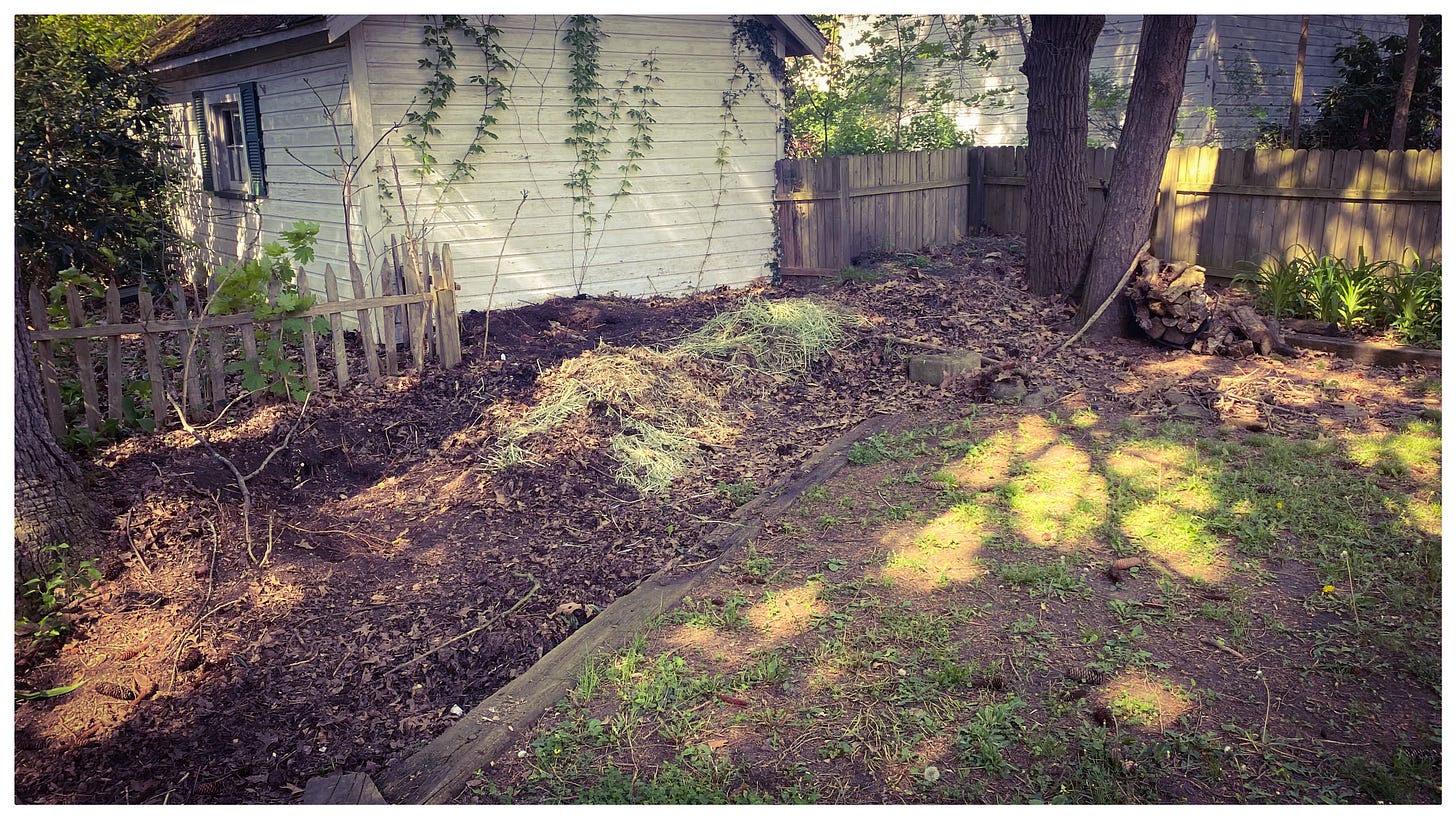Hi. I’m Hal and this is “Living in a Body.” Welcome! To hear me narrate the story with music, please click the play button. (9 minute listen) Also, would you do me one more favor? Please share this episode with one friend. Thank you! Hal
Black Gold
In my household, throwing an egg shell into the trash is considered a crime. Back when Hallie lived here, every once in a while, I’d peek into the can and there it would be — an egg shell, a banana peel or an apple core — sittin’ right there on top of the trash. I’d shout up the stairs in my most dad voice. I’d say, “Hallie! Get down here. What the heck is this? What were you thinking? C’mon Hallie, you know better than this.”
You see, we have a compost pile. My daughter is the third generation of a composting family. All year long, we collect food scraps in the kitchen and then we carry ‘em to the back corner of the yard where we bury them under the leaves. In the world of composting, cucumber peels, cooked quinoa that’s gone bad, little scraps of meat, moldy cheese, the skins of broccoli stalks, rotting carrots from the bottom of the fridge and egg shells are worth gold. In a visceral and almost ancestral way, seeing quality composting material on top of the trash just feels wrong.
All summer long, we dump grass clippings from the lawn mower onto the pile. And then in the fall, we rake leaves onto a big tarp and drag them to the back to create a mammoth pile of compost potential way back there. The whole back corner of the yard becomes the compost pile. All winter long, as the freeze slows the decomposition process, we offer the food that didn’t get eaten as a kind of sacrifice to the pile. I never feel bad about wasting food ‘cause I always know exactly where it’s going — to the compost pile.
In the Spring, in spite of having organic material added to it all winter long, the massive pile emerges from the cold considerably smaller. At the end of March, one pitchfork full at a time, I like to condense the pile into a manageable shape right next to the big pine tree. It’s there next to the pine tree that the miracle process of death turning into life continues.
There have been times when the daily pilgrimage to the compost pile has given me a sense of purpose — me and my bucket of scraps, trudging through the snow or the rain, participating in the great unfolding. When I return to the kitchen with an empty bucket, I feel like I’ve accomplished something worthwhile. It doesn’t always feel like a pilgrimage, but it never feels like a chore. With just this little bit of effort, year after year, the prize eventually comes. The prize is some of the finest compost in Northeastern Ohio. My mom and I call it “Black Gold.”
This brings us to last weekend. A couple rounds of friends came over to chop down the rye grass, spade the soil and move shovels full of good dirt from the bottom of the compost pile over to the vegetable garden. This black gold I’m talkin’ about is a real thing of beauty. It’s dark, rich and full of vibrant life. It’s interesting. I’ve been adding composted soil to my garden for nearly 20 years and the soil level has never risen. My sense is that hundreds and even thousands of pounds of organic material eventually melts down to just handfuls of the blackest gold a vegetable gardener could ever hope for.
A big part of the quality of the soil is because of the worms. It happens right around the middle of June. I turn the pitchfork and there they are -- earthworms. Within no time, those few worms become 20 or 50 and then every turn of the pile displays even a hundred big, juicy worms, squirming for their lives, trying to get back into the warmth of the pile. Now, if it were maggots or flies or ants, it would be gross, but because it’s worms, it’s a beautiful site. Worms in my compost pile are a sign of the good health of the pile. No matter what challenges are going on in my little world, I can turn a forkfull of leaves and find enough worms to know that all is right with the universe.
Composting is a slow process and it requires patience. You can’t really see it happening. But when the worms show up, things start moving along more quickly. I can put a bucket full of food scraps in the pile and within a couple days there is no sign of that food. It’s all been eaten and turned into high quality worm poop. A few times, I’ve gone even down to Starbucks to pick up some big bags of used coffee grounds to add to the pile. And the worms just keep eating. I imagine those worms get pretty buzzed on those hot summer Starbucks days.
About once a week, just to make sure those little squirmers don’t get too comfortable, I turn the compost with a pitchfork. With every turn of the rotting leaves, I can tell that the inside of the pile has turned into a hot oven. Steam rises up and fills the air with the intense smell of decomposition and transformation. As the summer passes, the pile gets cooked away. By the time fall arrives, it’s been cooked down to a sweet mound of living dirt sitting by the pine tree. The back corner of the yard is ready to go again with a new season of leaves. Sometimes I wonder where the worms go in the winter, but wherever they do go, the whole family keeps coming back year after year to my compost pile.
Tending a compost pile is one of the right actions of my life. This right action connects me to something bigger than myself. It puts me in tune with that part of myself that dwells in beauty, that knows patience and embraces the miracle of death equally as the miracle of life. I’m grateful to my dad who raised me in a composting family.
So Hallie, I can’t wait for the next time you come home, but don’t forget. Our scraps stay local. Apple peels don’t go in the trash. Old food doesn’t go down the disposal. We offer these scraps an opportunity for another life — to move through the great body of the earthworm, to get cooked in the deep warmth of the compost pile and to go on to birth a sugar snap pea, some rainbow chard or a sunflower reaching for the sky.
Thank you for reading. Big thanks for listening. Sometimes I wonder how many more of these I’ve got in me, but hopefully I’ll be back next week. Have a great Saturday! Hal
Follow me on Instagram. (115k followers)
Hang out with me on TikTok. (1.6M followers)
Grow with me on YouTube. (58k subscribers)
I haven’t figured out Twitter yet, but I’m there. (354 followers)
I stop by Facebook occasionally. (2.3k followers)
My website is super old but I’m hoping to revamp it soon.
Send me a postcard: P.O. Box 1043 Kent, Oh 44240
Finally, start your own Substack! I’d be happy to help you get started.




















Share this post